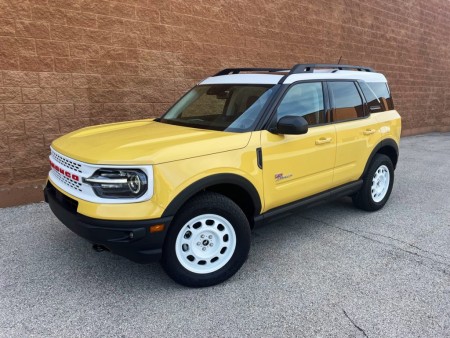Overview
If you’re the kind of person who spends weekends in the great outdoors—or perhaps you just want to look like you do—the 2024 Jeep Wrangler is an SUV that will take you just about anywhere you want to go. Jeep has come a long way from its military roots and offers plenty of creature comforts, and in fact, higher-end trims could be called luxurious. Now, that doesn’t necessarily mean the Wrangler will treat you to a pillowy ride or massage your backside on your way to the trailhead. It’s still a truckish thing, with road manners to match. Its ride can be jarring over broken pavement and its steering needs constant correction just to keep it heading in a straight line. By all accounts, the Ford Bronco and the Toyota 4Runner are more refined options with similar capabilities. However, Jeep offers many more powertrain options than its rivals, including a plug-in hybrid variant and a 470-hp V-8 that’s exclusive to the Rubicon 392 model.
What’s New for 2024?
The Wrangler picks up a mild visual and tech update for 2024, with an updated grille and no fewer than 10 new wheel designs. Inside, a new 12.3-inch infotainment display is standard across the board and replaces the smaller 5.0- and 7.0-inch screens from last year’s Wranglers. The new display also features Jeep’s latest infotainment software, as well as wireless Apple CarPlay and Android Auto. The onboard navigation system includes mapping for over 2000 trails, with the ability to download even more. Jeep has integrated a more robust active noise-cancellation feature to help quiet the cabin for phone calls. The plug-in hybrid 4xe powertrain can now be had on Sport and Rubicon X trims; hybrid models also gain a 3.6-kilowatt auxiliary battery to run accessories.
Pricing and Which One to Buy
We like the idea of staying close to the Wrangler’s simple roots while keeping the price toward the low end of the range, so we’d start with the two-door Wrangler—which comes standard with a removable cloth top. We don’t want to go full World War II bare bones, so we’d opt for the Wrangler Sport S for its extra equipment, which includes air conditioning, a leather-covered steering wheel, power windows and locks, automatic headlamps, heated mirrors, and more. Beyond that, we’d spec the 270-hp 2.0-liter turbocharged four-cylinder for its 295 pound-feet of torque—35 pound-feet more than the standard V-6. The four-cylinder also comes standard with an eight-speed automatic, a powertrain combination that should make for low-stress trail driving.
Engine, Transmission, and Performance
The Wrangler can be had with one of five different powertrains, starting with a 285-hp 3.6-liter V-6 that can be paired with a six-speed manual gearbox or a smooth-shifting eight-speed automatic. A turbocharged four-cylinder engine is optional and teams up with an electric motor to provide additional low-end power. In addition to the standard V-6 and optional four-cylinder hybrid, the Wrangler can also be equipped with a 3.6-liter V-6 with a similar hybrid assist, a 3.0-liter diesel V-6, a 375-hp plug-in hybrid 4xe powertrain, or a 6.4-liter V-8. Wranglers are born off-road ready, so part-time four-wheel drive is standard across the range and is controlled by a lever on the center console. In our testing, a base two-door Wrangler Sport with the V-6 and the six-speed manual transmission sprinted from to 60 mph in 6.1 seconds; a well-equipped four-door Sahara model with the automatic transmission did the deed in 6.8 seconds. With the four-cylinder hybrid powertrain, the four-door Sahara was slightly quicker at 6.5 seconds to 60 mph. The Rubicon model and the High Tide model—both of which carry additional weight in the form of heavier-duty off-roading equipment—weren’t as quick as the others in our testing. Performance at our test track shows that the Wrangler JL is much improved compared with the previous model, but it’s merely holding steady with its rivals in some metrics. Although its handling has improved, it’s still trucklike in comparison with today’s refined SUVs and pickups. The ride in the four-door is acceptably smooth over rough surfaces, but braking distances were inconsistent between our two test vehicles.
Range, Charging, and Battery Life
If the idea of tackling trails under electric-only power is appealing to you, then the 4xe powertrain is the obvious choice. The 17.0-kWh battery pack is said to provide up to 25 miles of electric-only driving, but Jeep says that’s enough for a few hours of low-speed off-roading. When the battery runs out, the turbocharged four-cylinder can drive all four wheels like a normal Wrangler, so you needn’t be concerned about being stranded without a charge.
Fuel Economy and Real-World MPG
In this segment of gas guzzlers, it doesn’t take much to be at the top of the class. The Wrangler’s EPA fuel-economy estimates put it ahead of rivals such as the Bronco and the 4Runner. The most fuel-efficient version features the diesel engine that tops out at 22 mpg city and 29 highway. The V-6-powered four-door Wrangler Sahara returned a 20-mpg result on our 75-mph highway fuel-economy route, 3 mpg fewer than its EPA rating for highway fuel economy. The turbocharged four-cylinder hybrid model fared much better, delivering 26 mpg—2 mpg more than expected. For more information about the Wrangler’s fuel economy, visit




